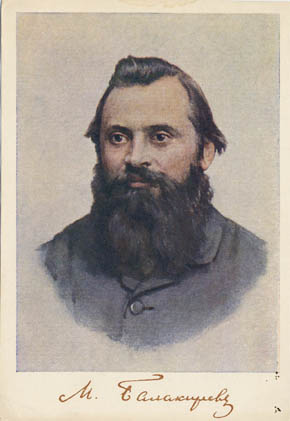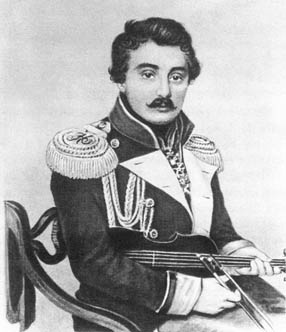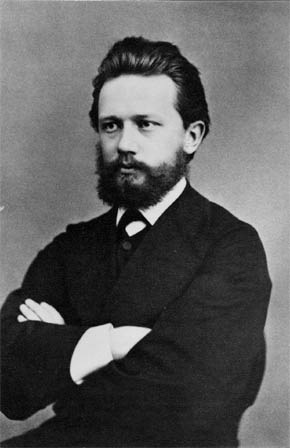Unless otherwise stated all pictures on Berlioz Photos page have been scanned from engravings, paintings, postcards and other publications in our own collection, including, on this page, Berlioz and the Romantic Imagination and Stasov’s Selected Essays on Music and various contemporary newspapers. All rights of reproduction reserved.
This page is intended to accompany two other related pages elsewhere on this site, Berlioz in Russia and Russian Friends and Acquaintances. Many (but not all) of the persons mentioned below are treated in detail in the latter page, and where relevant links to the entries there are provided. Included here are portraits or photographs of the following: Mili Balakirev, Alexander Borodin, César Cui, Berthold Damcke, Mikhail Glinka, General Alexei Lvov, Modest Mussorgsky, Nikolai Rimsky-Korsakov, Prince Odoievsky, Anton Rubinstein, Vladimir Stasov, and Pyotr Tchaikovsky.
![]()

Composer and an admirer of Berlioz; Balakirev was the conductor of the Russian Musical Society at the time of Berlioz’s second visit to Russia in 1867-8 and had frequent contacts with Berlioz during the stay. He was one of the well-known group of five Russian composers whose works were influenced to varying degrees by Berlioz’s music. The other four were Borodin, Cui, Mussorgsky, and Rimsky-Korsakov. Balakirev continued to champion Berlioz’s music after the death of the composer (see the page on Charles Malherbe and the section on the Breitkopf and Härtel edition of Berlioz’s works).

Borodin did not apparently meet Berlioz during his stay of 1867-8.

César Cui first met Berlioz in Paris in August 1867, a month before Berlioz received the invitation to come to Russia to give a series of concerts. During Berlioz’s stay he was in frequent contact with Berlioz and reviewed his concerts enthusiastically. He was instrumental in persuading Berlioz to allow a copy of the score of Les Troyens to be made, with a view to performance in Russia. The copy was made, but no performance took place. Berlioz remained in touch with Cui during the months after his return from Russia.

German musician and composer whom Berlioz first met in St Petersburg in 1847. Damcke settled in Paris in 1859, and the two men became close friends: Berlioz was a frequent visitor at the Damckes’ flat which was near his own, and was in regular contact with them; he wrote to Damcke during his stay in Russia (cf. CG nos. 3308, 3326). Damcke was one of Berlioz’s two testamentary executors.

The above lithograph is dated 1837 (artist unknown).
Berlioz first met Glinka in 1831 in Rome and saw him again in Paris in 1844-1845, when he included some of Glinka’s music in his concerts at the Cirque Olympique in Paris in 1845, and wrote an article praising his compositions. Berlioz attended a performance of Glinka’s his first opera, A Life for the Tsar, in Moscow during his first visit in 1847.


This monument, located on the Theatre Square, was inaugurated on 3 February 1906.

The above picture is courtesy of the Russian Anthems Museum.
Musician and composer, Lvov was director of the Imperial Chapel in St Petersburg; his close friendship with Berlioz, which started in 1847, is attested by a correspondence that lasted some 20 years until the end of the musical career of both men.

Mussorgsky did not apparently meet Berlioz during his stay of 1867-8.

The above engraving is dated 1889.
Rimsky-Korsakov did not apparently meet Berlioz during his stay of 1867-8. The influence of Berlioz on his own music is particularly clear: Harold en Italie with its prominent part for solo viola is an obvious ancestor of Rimsky Korsakov’s Scheherazade.

Prince Odoievsky was an amateur musician and writer whom Berlioz first met during his first visit to Russia in 1847, when Odoieksky wrote enthusiastic articles on Berlioz. But unlike Lvov and Stasov he does not seem to have maintained close relations with Berlioz subsequently.

The date of the above engraving is 1886.
Berlioz met Rubinstein during his second visit to Russia; Rubinstein founded the Russian Musical Society in 1859 and was the first director of the St Petersburg Conservatoire until August 1867.

The above picture is courtesy of Berlioz and the Romantic Imagination (London: The Arts Council 1969).
Stasov was one of Berlioz’s staunchest champions in Russia. Berlioz first met him in St Petersburg in 1847 (CG no. 1111), and saw him again in Paris in 1862 (cf. CG nos. 2650, 2676), but it was only in 1867-8 that they became closer and remained in touch to near the end of Berlioz’ life (CG nos. 3346, 3356, 3373, 3375).

The above portrait by Ilya Repin is courtesy of Vladimir Vasilievich Stasov, Selected Essays on Music, translated by Florence Jonas (London, Barrie & Rockliff, The Creset Press, 1968).

The above postcard shows an 1867 photo.

The above engraving is dated 1889.
![]()
© (unless otherwise stated) Monir Tayeb and Michel Austin for all the texts and images on Berlioz Photo Album pages.
All rights of reproduction reserved.